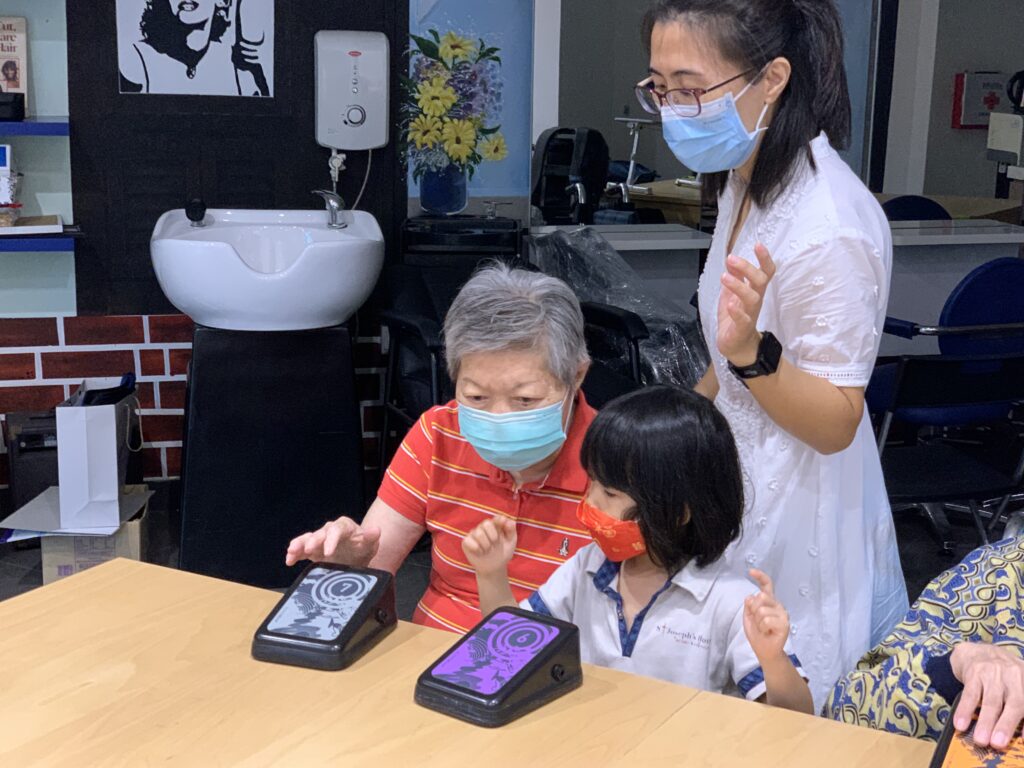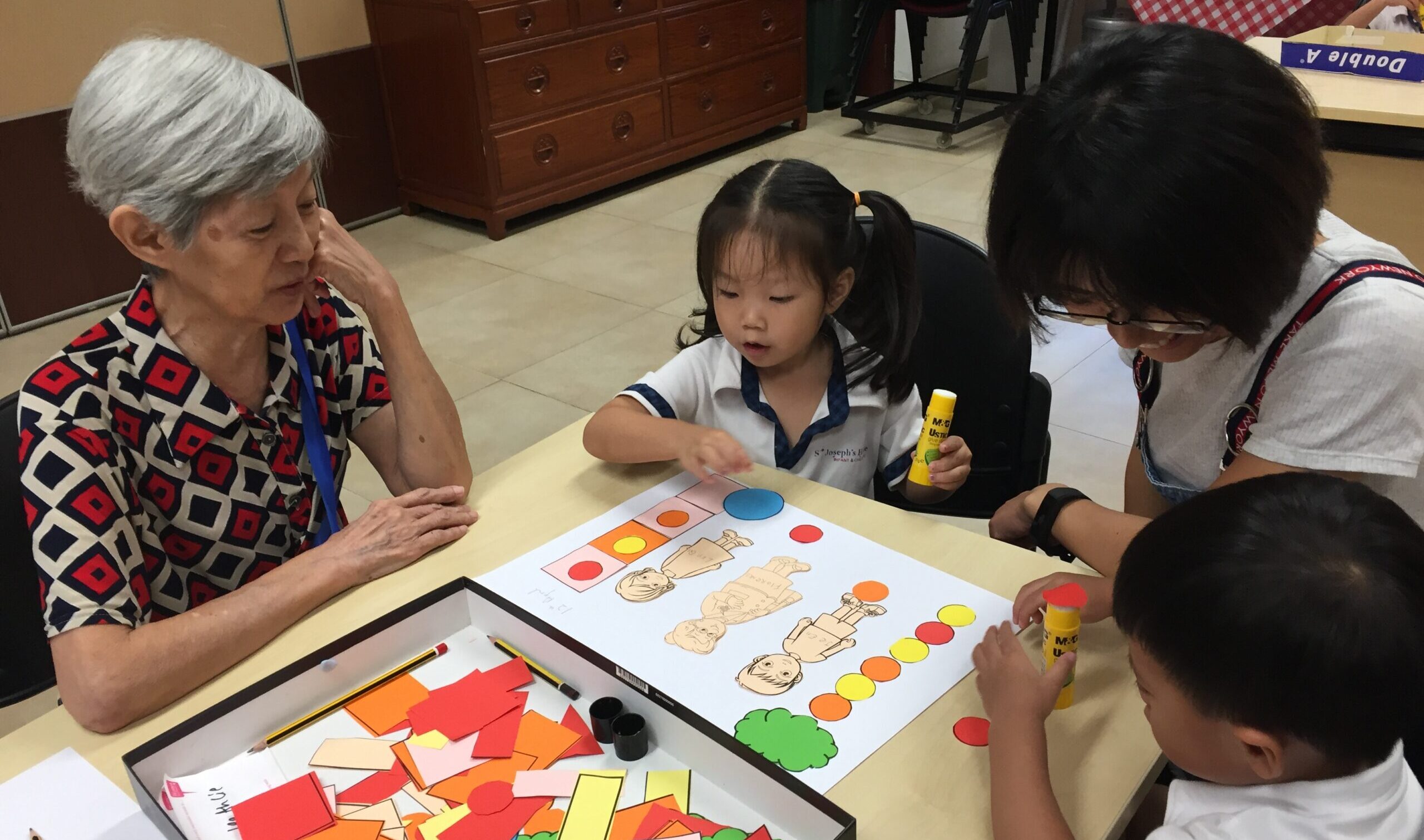Intergenerational bonding is such a buzz word these days.
What exactly is intergenerational bonding programmes?

Intergenerational bonding programmes are where the young and old, typically with a large age gap spanning two or more generations, interact and socialise with one another. The benefits of intergenerational programmes (IGPs) have been well documented (Canedo-Garcia et al., 2017).
To name just a few:
- Enhanced quality of life, well-being and generate sense of self-worth among older adults (Wong, et al., 2018)
- Challenge stereotypical thinking of older adults and improve confidence and communication skills of children towards older adults (Gualano, et al., 2018)
- Promote Grandparent-Grandchild-like Relationships (Bagnasco, et al., 2020)
Although Singapore, like most Asian countries, ascribes to the traditional values of respecting the older generations, Singapore is undergoing rapid social changes that impact the grandparent-grandchild relationship. For example, the:
- Decline in the number of multi-generational households (Ministry of Social and Family Development, Republic of Singapore, 2022), and;
- Increase language divide across generations (Singapore Department of Statistics, 2021c)
These two along contribute to reduced intergenerational interaction within the family (Tan and Ng, 2010), increased risk of social isolation among older adults and worsened ageist attitudes (Hagestad and Uhlenberg, 2005).


IGPs present valuable opportunities for intergenerational interactions outside the family, helping to reduce ageism within communities and enhance community-level relationships (Steward, et al., 2021).
IGPs are also a future-oriented solution to an ageing and age-segregated society. Educating and inspiring the next generation to respect and understand older adults can promote age-inclusive policies and practices (Steward, et al., 2021).
At St Joseph’s Home Infant and Childcare Centre, we enjoy a co-located facility with eldercare and childcare services being provided concurrently, and on the same premise (Goyer, 2001 cited in Jarrott and Bruno, 2007).
What’s so awesome about our co-located Infant and Childcare Centre at Jurong West?

As Singapore’s first and only co-located Infant and Childcare Centre, under the same management, we are thankful to enjoy many benefits:
- Continuity of planning IGPs and they can be planned, reviewed and improved on an ongoing basis
- More fluid and incidental interactions
- Reduced transportation costs so interactions become a way of life, rather than a planned learning journey
- Efficient use of resources, leading to more varied and creative programmes offered to both generations
How do we conduct IGPs in SJH Infant and Childcare Centre?
Since the invitation to develop the existing St Joseph’s Home Jurong West facility back in 2012, the intergenerational concept has been the vision of our leaders. It is the vision of SJH Infant and Childcare Centre when it was set up at the heart of Jurong West.
“We wanted IGPs to be very much part of the everyday life, everyday routine of the older person, of the younger person.”
Quote from Senior Management, St Joseph’s Home
Here are three key ways intergenerational interactions are embedded in SJH Infant and Childcare Centre:
Shared celebrations between the eldercare and childcare centres
Our nursing home residents and children from the SJH Infant and Childcare Centre celebrate important milestones together. For example, a joint graduation was held for residents “graduating” from their Gym Tonic Exercise programme and for graduating K2 batch.

Children also celebrate and learn about multicultural festivals in Singapore with the residents. For example, Racial Harmony Day saw children setting up booth activities for residents to play in.


We also have a yearly tradition of raising the National flag and reciting the pledge together as a SJH community. Even amidst COVID-19 restrictions, the childcare centre teachers arranged for a ‘safe distance’ way of celebrating festivals together.
Frequent interactions between the children and elderly
The childcare teachers work closely with the nursing home staff to introduce varied and creative programming that benefit both residents and children. These programmes happen not once a year, not twice a year, but daily.
Having an embedded intergenerational curriculum means that the children visit residents to learn about art, arithmetic, music, language or nature.

Monthly live stations was introduced for residents to enjoy themed monthly specials, such as roti prata and mee goreng. The children served as little helpers to deliver the food and drinks to residents at their bedside.

Community partnership and parental involvement
External partners such as puppet artists and music makers are brought in to run intergenerational programmes. Music Making MAGIC by I’m Soul Inc was introduced as a year-long collaboration for children and residents to express themselves creatively, without having any music background!


Parents are also key partners in cultivating respect and understanding for our elders. Our intergenerational sports day, organised by our in-house gym trainers, allowed parents and children to learn about the physical, cognitive and social aspects of ageing. It also became a wonderful bonding experience for families and residents!

Ready to be part of our intergenerational experience?
Running quality intergenerational programmes that forge real and lasting relationships require ongoing collaboration and effort.
Here in St Joseph’s Home, our infants, children and young volunteers interface with nursing home and hospice residents. Topics such as sickness, disability and death can come up. Hence, we believe in strong community partnership and parental involvement in raising up the next generation.
Believe in our vision too? Join us as a parent, volunteer, partner or staff.

